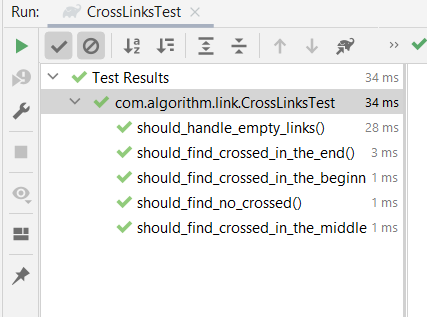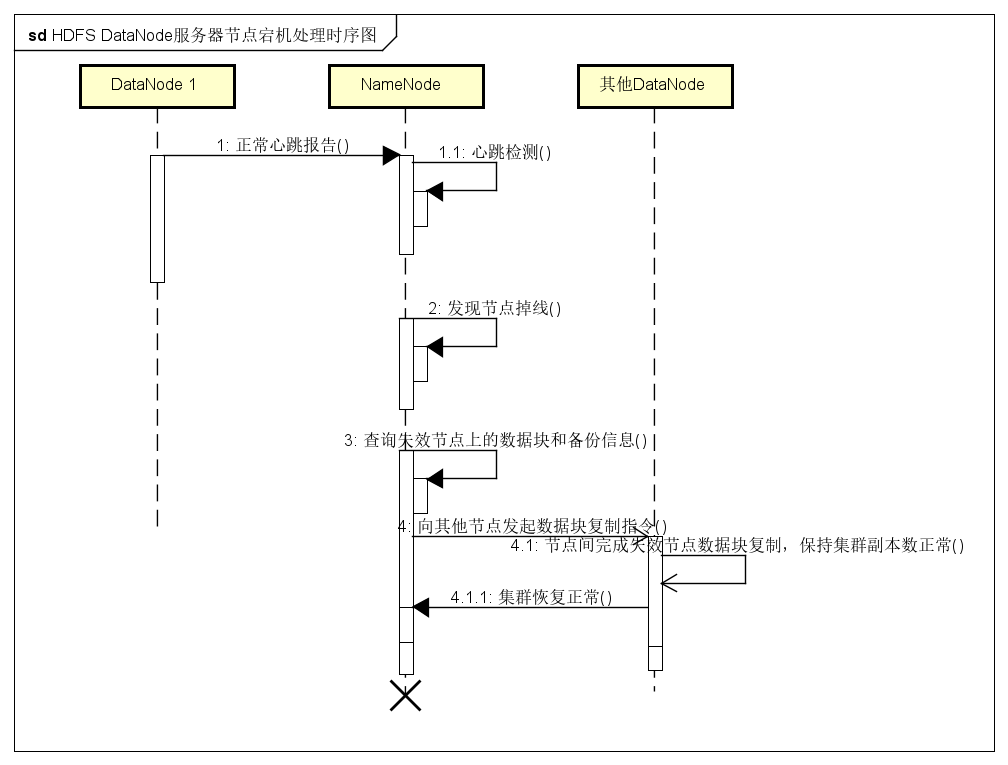week8-homework
发布于: 2021 年 01 月 12 日
有两个单向链表(链表长度分别为 m,n),这两个单向链表有可能在某个元素合并,也可能不合并,如下图所示的这样。现在给定两个链表的头指针,在不修改链表的情况下,如何快速地判断这两个链表是否合并?如果合并,找到合并的元素,也就是图中的 x 元素。
请用代码(或伪代码)描述算法,并给出时间复杂度。

算法实现如下,对于给定的两个链表,找到长的链表,并移动指针使得两个链表指针起点到终点是一样的距离,然后将两个指针同时按照一样的步长(1)向后移动,如果两个指针指向同一个节点,就是两条链表相加的节点,否则两个链表无相交。时间复杂度是 O(m+n),空间复杂度是 O(1)
package com.algorithm.link;
/** * @author lvlin * @date 2021-01-12 10:58 AM */public final class CrossLinks {
/** * Find the crossed node between two links * @param a first node for the first link * @param b first node for the second link * @return the crossed node or null for not crossed */ public Node findCrossedNode(Node a, Node b){ // parameter checking if (null == a || null == b) { return null; } if (a.getValue() == b.getValue()) { return a; }
// find the length of two links int lenA = 0; int lenB = 0; Node pA = a; while (pA.getNext() != null){ lenA++; pA = pA.getNext(); } Node pB = b; while (pB.getNext() != null) { lenB++; pB = pB.getNext(); }
// move the long link firstly to same length pA = a; pB = b; if (lenA > lenB) { for (int i = 0; i < lenA - lenB; i++) { pA = pA.getNext(); } } else if (lenA < lenB) { for (int i = 0; i < (lenB - lenA); i++) { pB = pB.getNext(); } }
// detect the crossing node while (pA != null && pB != null){ if (pA == pB){ return pA; } pA = pA.getNext(); pB = pB.getNext(); }
// no crossing at the end. return null; }}
复制代码
package com.algorithm.link;
/** * @author lvlin * @date 2021-01-12 10:59 AM */public final class Node { private final int value; private Node next;
public Node(final int value, Node next) { this.value = value; this.next = next; }
public int getValue() { return value; }
public Node getNext() { return next; }
public void setNext(final Node next) { this.next = next; }}复制代码
package com.algorithm.link;
import org.apache.commons.lang3.tuple.Pair;import org.junit.jupiter.api.Test;
import java.util.HashMap;import java.util.Map;
import static org.junit.jupiter.api.Assertions.*;
/** * @author lvlin * @date 2021-01-12 11:11 AM */class CrossLinksTest {
@Test void should_find_crossed_in_the_middle() { checkCross(new int[]{1, 3, 5, 6, 7, 9}, new int[]{2, 4, 5, 6, 7, 9}, new Node(5, null)); }
@Test void should_find_crossed_in_the_beginning() { checkCross(new int[]{1, 2}, new int[]{1, 4}, new Node(1, null)); }
@Test void should_find_crossed_in_the_end() { checkCross(new int[]{1, 2, 3, 9}, new int[]{7, 8, 9}, new Node(9, null)); }
@Test void should_find_no_crossed() { checkCross(new int[]{1}, new int[]{2}, null); checkCross(new int[]{1, 2}, new int[]{3, 4}, null); }
@Test void should_handle_empty_links() { // empty node checkCross(new int[]{}, new int[]{}, null); checkCross(new int[]{}, new int[]{1}, null); }
private void checkCross(final int[] nodes1, final int[] nodes2, final Node expected) { Pair<Node, Node> links = buildLinks(nodes1, nodes2); Node crossed = new CrossLinks().findCrossedNode(links.getLeft(), links.getRight()); if (expected == null) { assertNull(crossed); } else { assertEquals(crossed.getValue(), expected.getValue()); } }
private Pair<Node, Node> buildLinks(final int[] nodes1, final int[] nodes2) { Map<Integer, Node> nodes = new HashMap<>(); buildNodesMap(nodes1, nodes); buildNodesMap(nodes2, nodes);
linkNodes(nodes1, nodes); linkNodes(nodes2, nodes);
Node a, b; if (nodes1.length > 0) { a = nodes.get(nodes1[0]); } else { a = null; } if (nodes2.length > 0) { b = nodes.get(nodes2[0]); } else { b = null; }
return Pair.of(a, b); }
private void linkNodes(final int[] nodesValues, final Map<Integer, Node> nodes) { for (int i = nodesValues.length - 1; i >= 1; i--) { Node nextNode = nodes.get(nodesValues[i]); Node preNode = nodes.get(nodesValues[i - 1]); preNode.setNext(nextNode); } }
private void buildNodesMap(final int[] nodesValue, final Map<Integer, Node> nodes) { for (final int v : nodesValue) { if (nodes.containsKey(v)) { continue; } nodes.put(v, new Node(v, null)); } }
}复制代码

请画出 DataNode 服务器节点宕机的时候,HDFS 的处理过程时序图。

划线
评论
复制
发布于: 2021 年 01 月 12 日阅读数: 17
J
关注
还未添加个人签名 2015.06.24 加入
还未添加个人简介












评论